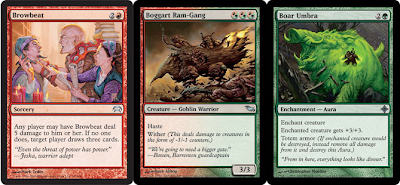The rationale behind anti-draft is that it avoids the frustration of passing a lot of great cards while still creating some natural color balance, and improving the overall deck quality relatively to sealed. We were five people, and two put together decks they were happy with, but the other three had trouble building their pools and decks..
Apparently, there are three main issues with this way of drafting:
1. Multicolored cards of combinations that no one was using were passed very frequently, to the point of almost locking the rounds when they approached the end, as no one wanted to pass a good card of a color someone was playing.
2. The table order affected too deeply the cards available - no one could go to a color that their "back" neighbor was playing, as no cards of that color were passed at all. Therefore, if your neighbor was drafting two colors, you were pretty much forced into the other three.
3. Nearly no bombs were passed, restricting each player to the ones he opened.
The final standings were:
- WG Control (4-0, 8-3)
- RG Beatdown (3-1, 6-2)
- UB Aggro-control (2-2, 5-5)
- WUG Control (1-3, 4-7)
- RB Control (0-4, 2-8)
Which was probably the first time we had a tournament with "transitive victories", that is, for any A, B and C, if (A won B) and (B won C), then (A won C), suggesting a higher power disparity between decks. The two that did better are detailed below:
WG Control
8 Forest
8 Plains
Jungle Shrine
Steel Wall
Ajani's Pridemate
Hand of Honor
Garruk's Companion
Troll Ascetic
Phantom Centaur
Stormfront Riders
Krosan Tusker
Phantom Nishoba
Accorder's Shield
Pacifism
Reprisal
Crystal Ball
Cage of Hands
Order/Chaos
Harrow
Wing Shards
Squirrel Nest
Phyrexian Processor
Elspeth, Knight-Errant
Stunted Growth
Kirtar's Wrath
Orochi Hatchery
How great Elspeth was actually worries me. The only planeswalker I had was Chandra Ablaze, which, despite being maybe the worst planeswalker printed, was an OK card. I just added Elspeth and Tezzeret the Seeker, and while I suppose Tezzeret is too situational to be dominant, Elspeth is a powerhouse. I don't want to do the first ban for power reasons, but the lack of answers for planeswalkers makes me worry they will kill the control archetype in the cube entirely.
Modern control decks require extremely general removal like Volition Reins, Maelstrom Pulse and Oblivion Ring. While I could improve on that category of removal, it's not numerous enough in the history of Magic to balance a singleton cube.
RG Beatdown
7 Mountain
5 Forest
City of Brass
Barbarian Ring
Rupture Spire
Kazandu Refuge
Treetop Village
Fireslinger
Tin Street Hooligan
Quirion Elves
Boggart Ram-Gang
Ghost-Lit Raider
Jaya Ballard, Task Mage
Coal Stoker
Anger
Bloodbraid Elf
Flame Elemental
Karstoderm
Indrik Stomphowler
Hoarding Dragon
Burst Lightning
Rancor
Giant Growth
Vulshok Gauntlets
Firespout
Chimeric Idol
Elephant Guide
Boar Umbra
Staggershock
Crusher Zendikon
Browbeat
Entangling Vines
Quenchable Fire
Harmonize
Earthquake


Ficou legal a disposição das imagens das cartas do segundo deck analisado, red, red/green, green =D
ReplyDelete